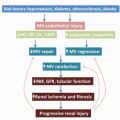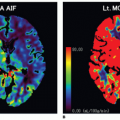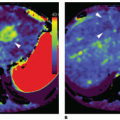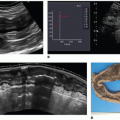Radiotracers
Thallium 201 (
201Tl) has been used for more than 40 years for MPI. It is administered by intravenous injection (usual dose of 80 to 110 MBq). The myocardial uptake is proportional to perfusion and in absolute terms amounts to 4% of the injected dose.
8 After intravenous administration, approximately 88% is cleared from the blood after the first circulation.
9 201 201Tl is a monovalent cation, similar in size to the hydrated potassium ion (K
+). Approximately 60% enters the cardiac myocytes using the sodium-potassium ATPase-dependent exchange mechanism, and the remainder enters passively along an electropotential gradient. The extraction efficiency is maintained under conditions of acidosis and hypoxemia and only when myocytes are irreversibly damaged is extraction reduced.
10 The biologic half-life during extraction of the myocardium is 60 to 90 minutes, when it is injected directly into the coronary arteries, but it is much higher (4 to 5 hours) in the case of intravenous administration, because of the balance that develops between
201Tl located intracellularly and
201Tl present in the intravascular space.
Although significant experience has been gained over time with this tracer, it has some limitations. First, it has a relatively long physical half-life (72 hours), which results in a high radiation burden for the patient. Eighty MBq deliver an effective dose of 11 mSv.
11 This is greater than the average dose received by the patient during angiography (8 to 10 mSv). Second, the relatively low injected dose of 80 to 110 MBq results in a low signal-to-noise ratio and images can be suboptimal, especially in obese patients. Third, the relatively low-energy emission leads to low-resolution images and significant attenuation by soft tissue. Electrocardiographic (ECG)-gated imaging is possible, but the low count statistics may be a cause for concern. For these reasons,
201Tl has mainly been superseded by technetium-based radiopharmaceuticals except for viability studies. With the use of novel CZT detector technology, smaller doses of tracer can be used to minimize radiation exposure, and this can be achieved without prolonging image acquisition and without loss of image quality, while technetium dose could be substantially lower than the standard dose (see below).
Two technetium (
99mTc)-labeled perfusion tracers are commercially available: Tc-99m-2-methoxy-isobutyl-isonitrile (MIBI) or sestamibi and Tc-99m-1,2-bis[bis(2-ethoxyethyl) phosphino] ethane (tetrofosmin). MIBI is a cationic complex that diffuses passively through the capillary and cell membrane. Roughly 2.8% of MIBI injected at rest and 3.2% of the dose during dynamic exercise are concentrated in the myocardium, which is smaller than that of
201Tl (4%). MIBI is mainly trapped in mitochondria and shows no significant redistribution for at least 2 to 3 hours after administration. Its elimination from the circulation is rapid, and its clearance occurs through the liver and kidneys.
12 Tetrofosmin is rapidly cleared from the blood, and the ultimate myocardial uptake is slightly less than that of MIBI.
13 The retention of the myocardium is satisfactory and in combination with rapid hepatic clearance makes it possible to obtain an image 20 minutes after the injection. The myocardial uptake mechanism is similar to that of MIBI (
Table 23.1).
Stress Tests
The response to the stress has a central role in assessing the function of the cardiovascular system. This is especially important in case of CAD, because flow at rest is normal until a diameter stenosis of around 80% of the lumen occurs. Most of these techniques use some type of stress of the cardiovascular system seeking to reveal differences in coronary flow reserve (CFR) between different arteries. Some of them cause myocardial ischemia due to the increased oxygen consumption by the myocardium, while others, such as, for example, the pharmacologic test with adenosine, alter blood flow levels without necessarily leading to ischemia. The most frequently used method is dynamic exercise, but in many patients, it is not feasible usually due to peripheral vascular disease and musculoskeletal diseases. Dynamic exercise is the method of choice and is applicable to patients who are able to achieve satisfactory load (at least 85% of their maximum heart rate appropriate to the age and sex of the patient). If the test is performed for diagnostic purposes, preparation of patients includes discontinuation of medications with anti-ischemic effect, ideally for five half-lives, provided that this is approved by the referring physician (the same applies also for pharmacologic stress with vasodilators). In addition, patients should avoid foods, liquids, and medicines that contain caffeine, while specific diet is not necessary. The aim is to perform a symptom-limited exercise test (see
Table 23.2). However, there are patients who are unable to undergo dynamic exercise, absolute contraindications of which are the following: a recent acute coronary syndrome (ACS) (the patient should be hemodynamically stable for at least 24 to 72 hours, after chest pain depending upon clinically assessed risk), left main stem stenosis that is likely to be hemodynamically significant, symptoms of heart failure (HF) at rest, a recent history of severe arrhythmia, aortic stenosis, hypertrophic cardiomyopathy (HCM), severe hypertension (systolic blood pressure >220 mm Hg or diastolic blood pressure >120 mm Hg), recent pulmonary embolism or infarction, thrombophlebitis or active deep vein thrombosis, active endocarditis, myocarditis, or pericarditis. Relative contraindications to the dynamic stress are left bundle branch block (LBBB), paced rhythm, movement disorders, and inability to complete a recent exercise test.
14 In these cases, administration of drugs that alter the coronary flow or myocardial oxygen consumption is the only option. There are currently four pharmacologic stressors: dipyridamole, adenosine, regadenoson, and dobutamine.
Dipyridamole dilates arteriolar coronary circulation by increasing adenosine levels in the plasma, which is a strong vasodilator substance, acting via the purinergic receptors. The increase of flow in the coronary circulation in normal subjects is about 250% to 600% of flow at rest. In patients with CAD, the administration of dipyridamole causes uneven increase in the flow and deficits in SPECT MPI. Dipyridamole is administered intravenously at a dose of 140 µg/kg/min for 4 minutes. The time required to achieve maximal vasodilation is about 4 minutes, and therefore, the radiopharmaceutical should be injected in the 8th minute of the test. The maximum increase of flow in the coronary circulation is maintained for 10 min and then returns to baseline levels within half and hour. The administration of dipyridamole is indicated as stress test to patients who cannot exercise to an adequate level as well as for those with LBBB or paced rhythm. Chest pain (not necessarily ischemic) appears in 20% of patients and significant arrhythmias in less than 2% of patients. Extracardiac effects (headache, dizziness, nausea, epigastric pain, flushing) are observed in 30% to 40% of patients treated by slow intravenous aminophylline (up to 250 mg), which is a specific antagonist.
15Adenosine dilates coronary vessels, and the main advantage is the very short half-life time in plasma, which is estimated at less than 10 seconds. This has the effect of reducing the duration of side effects, and this is the main reason why, while it is more expensive than is dipyridamole, many nuclear medicine laboratories prefer to use adenosine. It causes arterial vasodilation in most networks by acting on A2a receptors and increasing the level of intracellular cyclic adenosine monophosphate. This results in relaxation of smooth muscle fibers of small vessels and consequently vasodilation. Adenosine has negative chronotropic and inotropic effect by its action on the A1 receptors. Intravenous administration at a rate of 140 µg/kg/min results in maximal or near-maximal hyperemia in 92% of patients, with an average increase of the flow in normal coronary vessels by 4.4 times compared to the resting value. The time required to achieve maximum vasodilatation is about 2 minutes,
and therefore, the radiopharmaceutical may be given in the second to third minute of the test, and the test may be finished over 2.5 to 3 minutes later. Like dipyridamole, adenosine can be coupled with submaximal dynamic exercise when tolerated to reduce the frequency and severity of adverse effects associated with vasodilator infusion.
14 A bicycle ergometer, allowing a semirecumbent patient’s position, may be preferable to a treadmill, because intravenous infusions are easily managed when the patient is relatively steady. Heart rate, blood pressure, and ECG should be measured and recorded at baseline and every 2 minutes during the infusion. The tracer is injected between the 3rd and 4th minutes of the adenosine infusion or sooner if symptoms or other complications require.
As with dipyridamole, most of the perfusion defects are created by flow heterogeneity between normal arteries and arteries with stenotic lesions. Ischemia is uncommon but may be caused by coronary steal, when collateral circulation is present. ST segment depression is observed in 15% of patients being investigated for CAD and in 25% of patients with known CAD, which is less than that observed during dynamic stress. Side effects are present in 80% of patients. Chest pain (not necessarily ischemic) is common seen in up to 40% of patients.
14,
16 Other side effects are headache, facial redness, and atrioventricular (AV) block. Because the half-life of the drug in plasma is very short (10 seconds), side effects disappear rapidly. Contraindications and preparation for testing with adenosine are similar to those of dipyridamole and regadenoson.
To avoid the side effects of vasodilator stress, agonists with a high selectivity for the adenosine A
2A receptor responsible for the coronary vasodilator effect of adenosine have been developed. Of all compounds, regadenoson (Rapiscan, United Kingdom, or Lexiscan, United States) is the most commonly available for use in Europe and United States. Regadenoson has a rapid onset of action with peak coronary vasodilation by 30 seconds after administration and a short-lasting vasodilator effect of 2.30 minutes that is sufficient for adequate myocardial tracer extraction. Regadenoson was tested in two randomized double-blind studies of over 2,000 patients, and the results demonstrated that beyond its appealing features for clinical use, such as ease of administration as a rapid injection over 10 seconds and single non-weight-adjusted dose of 400 µg, regadenoson has comparable efficacy to adenosine and a similar side effect profile but better tolerability compared to the latter.
17,
18 Moreover, regadenoson can be used safely in patients with mild-to-moderate reactive airway disease and obstructive lung disease.
19,
20 Like adenosine and dipyridamole, regadenoson can also be combined with submaximal exercise when tolerated. Regadenoson has also been used during dynamic exercise when maximal exercise is not achieved, but there is little evidence for the effectiveness and safety of this approach.
Absolute contraindications for the administration of the above vasodilators are known bronchospasm requiring treatment with steroids, second- and third-degree AV block in the absence of functioning pacemaker, hypotension (systolic pressure <90 mm Hg), taking xanthine or dipyridamole during the last 24 hours, known or suspected sinoatrial disease, and any other cases in which a stress test is contraindicated (e.g., acute HF, hemodynamic instability). Relative contraindications are recent cerebral ischemia or infarction.
14 Patients with well-controlled or mild asthma or chronic obstructive pulmonary disease (COPD) can be stressed with adenosine. The latter can be given as a titrated protocol starting at a low dose of 70 or 100 µg/kg/min for a minute and increasing if tolerated up to 140 µg/kg/min with tracer injection two minutes after the maximal dose of 140 µg/kg/min. Patients who are already on a β
2-adrenergic agonist such as salbutamol can be given two puffs of the inhaler prior to starting the adenosine infusion.
In patients stressed with the vasodilators, dipyridamole should be withheld for at least 24 hours prior to adenosine or 48 hours before regadenoson administration. Patients must also avoid aminophylline and theophylline as well as consumption of any foods and drinks containing caffeine (coffee, tea, chocolate) or caffeine-containing medications, for a minimum of 24 hours prior to the test.
7 Caffeine ingestion may attenuate the normal vasodilator response to adenosine, dipyridamole, and regadenoson. Attenuation of adenosine-induced perfusion abnormality by caffeine (in patients who have consumed caffeine within 12 hours prior to the test) can be overcome by increasing the adenosine dose to 210 µg/kg/min.
Dobutamine is used in patients with asthma or COPD, where vasodilators cannot be administered and a dynamic stress test is not feasible. Dobutamine increases myocardial perfusion in two ways: (a) causing vasodilatation through direct action into β
2 receptors and (b) increasing the oxygen consumption due to an increase in heart rate and myocardial contractility. The increase of coronary flow due to dobutamine is greater than that induced by dynamic exercise, but lower than that with dipyridamole or adenosine.
21 The half-life in the plasma is approximately 90 seconds. Dobutamine is administered intravenously by a peripheral vein (initial dose of 5 to 10 µg/kg/min and then the dose is increased to 15, 20, 30, and 40 µg/kg/min every 3 to 5 minutes). The preparation of patients includes discontinuation of β-adrenergic antagonists for five halflives, if possible, or at least for 24 hours. When dobutamine is used in echocardiography stress studies (stress echo), the additional intravenous atropine administration is useful (if there are no contraindications) when there is no satisfactory increase in heart rate. However, the use of atropine is less frequent in scintigraphic imaging, for the reason that the main mechanism of action of dobutamine is vasodilation, and therefore, the creation of perfusion deficits in patients with CAD is the result of inhomogeneous flow increase in coronary vessels. Intravenous administration of dobutamine in patients with CAD is safe, and serious complications occur rarely. Chest pain occurs in one-third of the patients, palpitation in 10%, and transient ventricular tachycardia, causing no hemodynamic changes, in 4% of patients. The effects of dobutamine are resolved by the administration of β-blockers. Given the positive chronotropic and inotropic action, dobutamine should not be used as a stress test in patients with contraindications to dynamic exercise as well as known hypokalemia. Relative contraindications are LBBB and paced rhythm, because dobutamine, like dynamic exercise, can cause septal perfusion defects even in the absence of epicardial CAD.

















